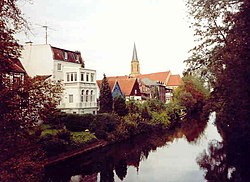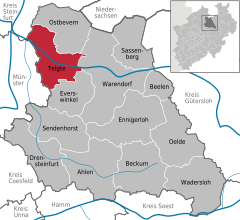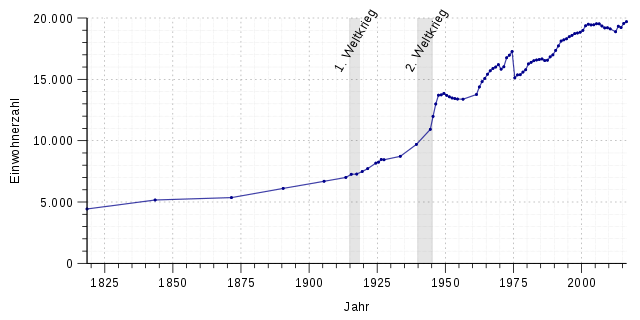Loading AI tools
Town in North Rhine-Westphalia, Germany From Wikipedia, the free encyclopedia
Telgte (German pronunciation: [ˈtɛlktə]; regionally [ˈtɛlçtə])[3] is a town in the Warendorf district, North Rhine-Westphalia, Germany, on the river Ems 12 km east of Münster and 15 km west of Warendorf. Telgte is famous as a place of pilgrimage, the Marian pilgrimage from Osnabrück to Telgte.
You can help expand this article with text translated from the corresponding article in German. (December 2022) Click [show] for important translation instructions.
|
Telgte | |
|---|---|
 Old Town and River Ems | |
Location of Telgte within Warendorf district  | |
| Coordinates: 51°58′55″N 7°47′08″E | |
| Country | Germany |
| State | North Rhine-Westphalia |
| Admin. region | Münster |
| District | Warendorf |
| Government | |
| • Mayor (2020–25) | Wolfgang Pieper[1] (Greens) |
| Area | |
| • Total | 90.6 km2 (35.0 sq mi) |
| Elevation | 54 m (177 ft) |
| Population (2023-12-31)[2] | |
| • Total | 20,301 |
| • Density | 220/km2 (580/sq mi) |
| Time zone | UTC+01:00 (CET) |
| • Summer (DST) | UTC+02:00 (CEST) |
| Postal codes | 48291 |
| Dialling codes | 02504 |
| Vehicle registration | WAF, BE |
| Website | www.telgte.de |
Telgte borders the cities Münster, Geven, Ostbevern, Warendorf, and Everswinkel.
Telgte divides into the main city and two districts, Westbevern-Dorf and Westbevern-Vadrup.
Until 1974, Westbevern (population: about 4000; area of 24,46 km²) was an independent town, with Dorf, Vadrup, and Brock as its districts. Since the reform of the municipal area reform, Brock has been a part of the neighboring town Ostbevern. The Bever runs as a tributary to the Ems through Westbevern. With its double-mill at the Bever, Haus Langen is a popular destination for tourists. For a couple of years, the neo-gothic church St Cornelius and Cyprian was a part of the parish community St. Marien (Telgte and Westbevern.)
The region around Telgte was already inhabited by Saxon tribes during post-Roman times. In the course of the Saxon wars at the hands of Charlemagne, this region was Christianised. Ludgerus, the first bishop of Münster, built a church in Telgte. This parish church was probably a wooden construct.
Telgte developed at a fork of larger trade routes to the North Sea and Baltic Sea, due to a ford that was able to cross the river, Ems.
Telgte received town privileges in 1238. 1469 Telgte is mentioned as a member of the Hanseatic League.
Around 1500 there were several large fires. In one of these fires, the old church perished. Prince-Bishop Franz von Waldeck of Münster was granted asylum in Telgte during the Münster Rebellion of the Anabaptists in the 1530s. Telgte suffered from the plague three times, so in 1599 more than half of the inhabitants died.
The Jewish community in Telgte existed until 1941. During Kristallnacht, the synagogue was desecrated and destroyed and the cemetery was removed in 1942, by Brownshirts and students. Today, commemorative plaques at these locations remind us of Telgte's Jewish history.
During the 20th century, Telgte's structure was formed, adding Westbevern to its district.
Telgte is famous for the annual Telgte Pilgrimage, the second-largest pilgrimage in Germany. Dedicated to the Blessed Virgin Mary and beginning in Osnabrück, the summertime pilgrimage regularly consists of 8,000 pilgrims. Approximately 150,000 pilgrims visit Telgte annually. Telgte is also known for its Nativity Museum (Krippenmuseum) and its fair (the Birth of Mary Market).
Nobel Prize winner Günter Grass's novel The Meeting at Telgte (Das Treffen in Telgte) is set in Telgte during the negotiations of the Peace of Westphalia which ended the Thirty Years' War.
Telgte is nationally known for its nativity museum, which is today part of the RELíGIO - Westphalian Museum for Religious Culture, the Birth of Mary Market with a show jumping tournament that attracts around 40,000 visitors every September, and the Telgter Pilgrimage, the annual Marian pilgrimage from Osnabrück to Telgte. It is one of the largest in Germany with around 8,000 pilgrims regularly. Up to 150,000 pilgrims come to Telgte every year.
In addition, the carriage pilgrimage takes place once a year on Ascension Day, where over 100 carriages often present themselves. This pilgrimage attracts many spectators to the city center and the Planwiese, a large event area in the city.
Other events that take place on the Planwiese in Telgte: a show of hot air balloons, the Montgolfiade, takes place on the first weekend in May and the large Birth of the Birth of Mary Market takes place in September. Medieval festivals also take place regularly during summer. Until 2014, Germany's largest medieval Christmas market with lights took place in Telgte during Advent.
Exhibitions are also occasionally held in Telgte. In 2009, Christel Lechner's Everyday People were on display, and in the summer of 2011 HA Schult's Trash People were on display. From April to July 2015, the Everyday People were once again exhibited in the historic part of the city.
The forest cemetery Lauheide with over 35,000 graves is located in the area of the city of Telgte near the city border of Münster. The Office for Green Spaces and Environmental Protection of the City of Münster, which owns the cemetery, is responsible for it.


→ Main article: List of monuments in Telgte

The Marienlinde is an approx. 750-year-old, heritage-protected summer linden, and is one of the oldest trees in Germany. The ‘tree veteran’ stands at the northern city gate, the cathedral gate. The linden tree got its name from the image of the Virgin Mary that is said to have been carved from its wood.

|
|
|
|
|
|
¹ Correction of the updating numbers by the census 1970
The city of Telgte consists of three parts: Telgte, Westbevern and Westbevern-Vadrup. Until the 1970s Westbevern was an independently administered village that consisted of Vadrup and Brock (Brock was incorporated into Ostbevern in a communal reform). Through Westbevern flows the river Bever, a tributary of the Ems. An attractive tourist destination is Haus Langen, with a former double mill at the Bever.
Telgte is twinned with:
| Term | Mayor |
|---|---|
| 1946–1947 | Wilhelm Lütke-Schwienhorst, CDU |
| 1947–1949 | Ferdinand Busch, CDU |
| 1949–1951 | Friedrich Sube, Zentrum |
| 1951–1952 | Heinrich Decker, CDU |
| 1952–1964 | Bernhard Rumphorst, CDU |
| 1964–1967 | Wilhelm Hotte, CDU |
| 1967–1969 | Friedrich Koppernagel, CDU |
| 1969–1975 | Günter Karthaus, CDU |
| 1975–1978 | Albert Bruens, CDU |
| 1978–1984 | Günter Karthaus, CDU |
| 1984–1996 | Reinhold Hotte, CDU |
| 1996–1999 | Klaus Beck, SPD |
| 1999–2004 | Ulrich Roenigh, CDU |
| 2004–2009 | Dr. Dietrich Meendermann, CDU |
| since 2010 | Wolfgang Pieper, BÜNDNIS 90/DIE GRÜNEN |
Seamless Wikipedia browsing. On steroids.
Every time you click a link to Wikipedia, Wiktionary or Wikiquote in your browser's search results, it will show the modern Wikiwand interface.
Wikiwand extension is a five stars, simple, with minimum permission required to keep your browsing private, safe and transparent.